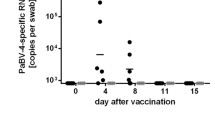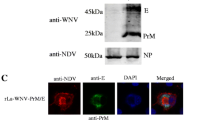Abstract
Duck short beak and dwarfism syndrome (SBDS) is a viral infectious disease caused by novel goose parvovirus (NGPV), which has been responsible for serious economic losses to the Chinese duck industry in recent years. Currently, there is no effective vaccine against this disease. In this study, we developed an inactivated virus vaccine candidate for SBDS based on NGPV strain DS15 isolated from a duck in China. Immune efficacy was evaluated in 112 ducks, which were randomly divided into vaccination, challenge-control, vaccination-challenge, and blank control groups (28 per group). Clinical characteristics, antibodies, virus excretion, viremia, and pathological changes were monitored. No morbidity or death was observed in the immunized ducks, which showed normal weight and a good mental state. High levels of serum antibodies (optical density at 450 nm of ~ 0.63) were detected in ducks immunized with the inactivated vaccine at 7 days post-vaccination (dpv), and the titer of virus-neutralizing antibodies increased from 1:23 to 1:28.5 from 7 to 42 dpv. Measurement of the viral load in anal swab, serum, and tissue samples showed that vaccination significantly inhibited the replication of NGPV in immunized ducks. Moreover, NGPV could not be isolated from the spleens of immunized or vaccinated and challenged ducks. Collectively, these results demonstrate that the newly developed inactivated NGPV vaccine, administered in an oil emulsion adjuvant, possesses good immunogenicity and represents a potentially powerful tool for SBDS prevention and control.






Similar content being viewed by others
References
Palya V, Zolnai A, Benyeda Z, Kovács E, Kardi V, Mató T (2009) Short beak and dwarfism syndrome of mule duck is caused by a distinct lineage of goose parvovirus. Avian Pathol J WVPA 38:175–180. https://doi.org/10.1080/03079450902737839
Shen H, Zhang W, Wang H, Zhou Y, Shao S (2015) Identification of recombination between Muscovy duck parvovirus and goose parvovirus structural protein genes. Adv Virol 160:2617–2621. https://doi.org/10.1007/s00705-015-2541-9
Lu YS, Lin DF, Lee YL, Liao YK, Tsai HJ (1993) Infectious bill atrophy syndrome caused by parvovirus in a co-outbreak with duck viral hepatitis in ducklings in Taiwan. Avian Dis 37:591-596. https://pubmed.ncbi.nlm.nih.gov/8395811/
Li C, Li Q, Chen Z, Liu G (2016) Novel duck parvovirus identified in Cherry Valley ducks (Anas platyrhynchos domesticus), China. Infect Genet Evol J Mol Epidemiol Evol Genet Infect Dis 44:278–280. https://doi.org/10.1016/j.meegid.2016.07.020
Ning K, Wang M, Qu S, Lv J, Yang L, Zhang D (2017) Pathogenicity of Pekin duck- and goose-origin parvoviruses in Pekin ducklings. Vet Microbiol 210:17–23. https://doi.org/10.1016/j.vetmic.2017.08.020
Xiao S, Chen S, Cheng X, Lin F, Wang S, Zhu X, Yu B, Huang M, Wang J, Wu N, Zheng M, Chen S, Yu F (2017) The newly emerging duck-origin goose parvovirus in China exhibits a wide range of pathogenicity to main domesticated waterfowl. Vet Microbiol 203:252–256. https://doi.org/10.1016/j.vetmic.2017.03.012
Chen S, Wang S, Cheng X, Xiao S, Zhu X, Lin F, Wu N, Wang J, Huang M, Zheng M, Chen S, Yu F (2016) Isolation and characterization of a distinct duck-origin goose parvovirus causing an outbreak of duckling short beak and dwarfism syndrome in China. Adv Virol 161:2407–2416. https://doi.org/10.1007/s00705-016-2926-4
Chen H, Dou Y, Tang Y, Zheng X, Niu X, Yang J, Yu X, Diao Y (2016) Experimental reproduction of beak atrophy and dwarfism syndrome by infection in cherry valley ducklings with a novel goose parvovirus-related parvovirus. Vet Microbiol 183:16–20. https://doi.org/10.1016/j.vetmic.2015.11.034
Li P, Lin S, Zhang R, Chen J, Sun D, Lan J, Song S, Xie Z, Jiang S (2018) Isolation and characterization of novel goose parvovirus-related virus reveal the evolution of waterfowl parvovirus. Transbound Emerg Dis 65:e284–e295. https://doi.org/10.1111/tbed.12751
Jin M, Feng C, Wang X, Zhang D (2019) Molecular evidence of goose-parvovirus-related abnormal molting in Pekin ducks. Adv Virol 164:2837–2841. https://doi.org/10.1007/s00705-019-04393-9
Fan W, Sun Z, Shen T, Xu D, Huang K, Zhou J, Song S, Yan L (2017) Analysis of evolutionary processes of species jump in waterfowl parvovirus. Front Microbiol 8:421. https://doi.org/10.3389/fmicb.2017.00421
Wan C, Liu R, Chen C, Cheng L, Shi S, Fu G, Chen H, Fu Q, Huang Y (2019) Novel goose parvovirus in domestic Linwu sheldrakes with short beak and dwarfism syndrome, China. Transbound Emerg Dis 66:1834–1839. https://doi.org/10.1111/tbed.13280
Wang D, Shi J, Yuan Y, Zheng L, Zhang D (2013) Complete sequence of a reovirus associated with necrotic focus formation in the liver and spleen of Muscovy ducklings. Vet Microbiol 166:109–122. https://doi.org/10.1016/j.vetmic.2013.05.022
Zhou J, Tang A, Qi R, Liu G (2020) Development and preliminary application of a SYBR Green I fluorescence quantitative PCR assay for a novel duck parvovirus. Chin J Anim Infect Dis 28:47–51. https://kns.cnki.net/kcms/detail/detail.aspx?FileName=ZSJB202004007&DbName=CJFQ2020
Zadori Z, Erdei J, Nagy J, Kisary J (1994) Characteristics of the genome of goose parvovirus. Avian Pathol J WVPA 23:359–364. https://doi.org/10.1080/03079459408419004
Lee MS, Cohen B, Hand J, Nokes DJ (1999) A simplified and standardized neutralization enzyme immunoassay for the quantification of measles neutralizing antibody. J Virol Methods 78:209–217. https://doi.org/10.1016/S0166-0934(98)00178-5
Takehara K, Saitoh M, Kiyono M, Nakamura M (1998) Distribution of attenuated goose parvoviruses in Muscovy ducklings. J Vet Med Sci 60:341–344. https://doi.org/10.1292/jvms.60.341
Schettler CH (1973) Virus hepatitis of geese. 3. Properties of the causal agent. Avian Pathol J WVPA 2:179–193. https://doi.org/10.1080/03079457309353795
Gough RE (1984) Application of the agar gel precipitin and virus neutralisation tests to the serological study of goose parvovirus. Avian Pathol J WVPA 13:501–509. https://doi.org/10.1080/03079458408418551
Kisary J (1977) Immunological aspects of Derzsy’s disease in goslings. Avian Pathol J WVPA 6:327–334. https://doi.org/10.1080/0307945770841824
Funding
This work was supported by the Key Research Project of National Science and Technology (grant numbers 2016YFD0500108, 2016YFD0501003) and the Chinese Natural Sciences Foundation (Grant number 31672572).
Author information
Authors and Affiliations
Corresponding authors
Ethics declarations
Conflict of interest
The authors have no relevant financial or non-financial interests to disclose.
Ethical approval
All animal experiments were approved by the Animal Welfare and Ethics Committee of Shanghai Veterinary Research Institute, Chinese Academy of Agricultural Sciences (approval number SHVRI-ZD-2019-032).
Additional information
Handling Editor: Ana Cristina Bratanich.
Publisher's Note
Springer Nature remains neutral with regard to jurisdictional claims in published maps and institutional affiliations.
Supplementary Information
Below is the link to the electronic supplementary material.
Rights and permissions
About this article
Cite this article
Zhou, J., Li, C., Tang, A. et al. Immunogenicity of an inactivated novel goose parvovirus vaccine for short beak and dwarfism syndrome in Cherry Valley ducks. Arch Virol 167, 881–889 (2022). https://doi.org/10.1007/s00705-021-05352-z
Received:
Accepted:
Published:
Issue Date:
DOI: https://doi.org/10.1007/s00705-021-05352-z




